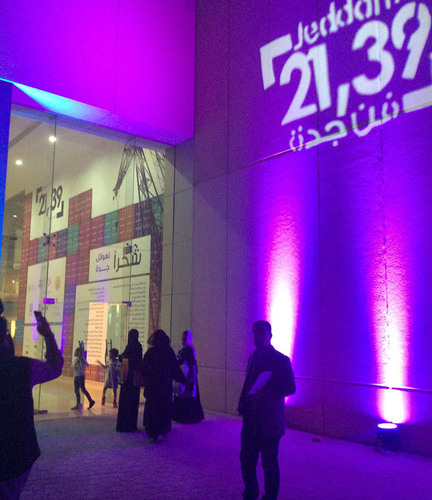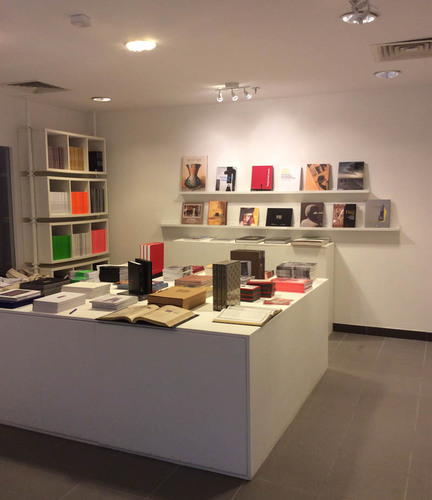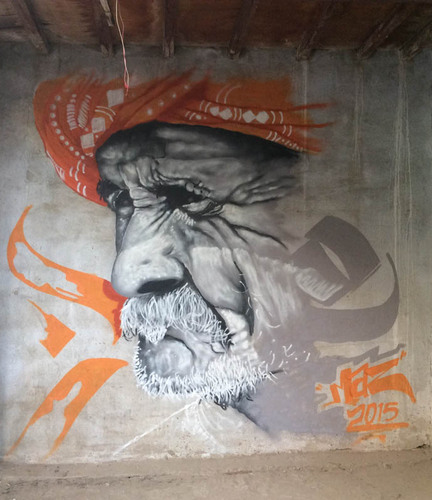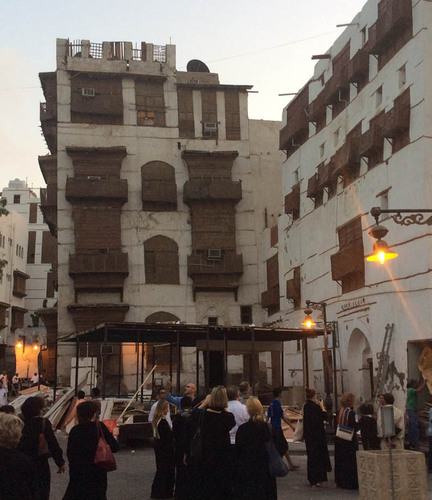Casa Árabe takes part in 21-39 Jeddah Arts
Casa Árabe’s Culture Coordinator, Nuria Medina, attends the contemporary art and culture events organized in this Saudi Arabian city
January 30, 2015
YEDA (ARABIA SAUDí)
On the dates of January 21-24, the city of Jeddah hosted the second edition of 21-39 Jeddah Arts, a non-profit initiative promoted by the Saudi Art Council platform, the president of which is H.R.H. Prince Jawaher bint Majed bin Abdulaziz. This group is made up of art patrons and enthusiasts in the Saudi art world who have decided to take on the challenge of contributing to the development of the local community by promoting art and culture.
21-39 Jeddah Arts includes the geographic coordinates of the city of Jeddah as part of its name. Throughout these days, the promoters intend to put this Saudi city on the map of the vibrant art scene being created in the Gulf region in recent years. 21-39 Jeddah Arts began on January 21 and brought together those responsible for events in the world of culture and institutions from the region and further afield (Casa Árabe, Art Dubai, Sharjah Biennial, Darat al Funoun, Tate Modern, New Museum, Delfina Foundation, Canvas Magazine, NYU Abu Dhabi, ArtReoriented), as well as collectors, publishers, curators, scholars and modern and contemporary art experts from the Arab world. Bahrain’s Minister of Culture, Sheikha Mai Bint Mohammed al Khalifa, was also among those attending.
The days’ schedule included the official opening of several art exhibitions, a symposium and visits to art galleries and the city’s historical center. However, the unexpected death of H.M. King Abdullah Bin Abdul Aziz Al Saud on Friday, January 23, forced organizers to cancel the official events as of that date.
Jeddah, at the cutting edge of the region’s contemporary art scene
During the oil boom in Saudi Arabia in the late seventies and throughout the eighties, a great effort was made to bring art to the city of Jeddah, and more specifically to its public spaces. Then mayor of the city, Mohammed Said Farsi, promoted a visionary initiative unparalleled around the world, which consisted of acquiring a large number of large format sculptures and putting them in place along the seaside walkway of Corniche al Hamra, turning the city into one of the largest open-air museums in the world. This collection includes very important works by essential artists from the twentieth century, including Joan Miró, Jean Arp, César Baldaccini, Alexander Calder and Henry Moore. In 2011, a renewed interest in the art world within the region and this city was reflected by works to restore the walkway, with the patronage of H.R.H. Prince Khalid Al Faisal, governor of the western region, and above all the initiative of Saudi art lover Basma Alsulaiman, who, with the support of the Abdulatif Jameel Foundation, created a new public park to display the most important works from the collection made during the preceding decades, for the enjoyment of visitors and local families.
One of the 21-39 Jeddah Arts program’s main exhibitions this year was the display Fast Forward, curated by Bashar al Shroogi, of Bahraini origin and currently the director of the Cuadro Gallery in Dubai. Al Shroogi has performed the first compilation of art works representative a large number of Saudi artists, as well as a wide range of materials (catalogues, press clippings, photographs, newspapers, etc.) which make it possible to document the development of visual arts in Saudi Arabia as of the second half of the twentieth century (bear in mind that the Saudi state was created in 1932). The exhibition, structured along a timeline, presents the first results of research, which must be extended in time. It will be given the form of an archives thanks to the promotion of the Saudi Arts Council. This initiative demonstrates this group of patrons’ steadfast desire to build a national art history that makes it possible to fill the void of knowledge which has existed up to now (in this sense, one must underline the exceptional nature of the volume titled “Contemporary Kingdom: The Saudi Art Scene now,” published by Canvas Central in 2014).
The result is extraordinary, because it highlights the existence of a historical art scene rich with artists and initiatives, and it radically questions the widespread idea that the art world in Saudi Arabia is a recent phenomenon resulting from globalization. In effect, though the exhibition ends with the work of current artists who are very well-known in the contemporary scene, such as Manal Aldowayan, Ahmed Mater, Abdunasser Ganem and Maha Mallouh, the first rooms are dedicated to some pioneers in Saudi modern art. Artists who, though in many cases they received training for a time in European countries, spent a large portion of their careers in Saudi territory, contributing to a corpus of artistic creation which few of us have learned about until now. It is interesting to know that one of these pioneers, Abdel Halim Radwi, who, according to what is shown at this exhibition, was the first artist to hold a solo exhibition in Saudi Arabia in the mid-1960’s, had strong ties with Spain, where he lived for several years, having even created the Association of Arab Artists in Spain.
The schedule of events also included a visit to some local art galleries. The Hafez Gallery hosted the exhibition “Section 11” by artist Rashed Al Shashai, who is representative of a new generation of Saudi artists. His art work is the result of his dual status as an art researcher and teacher at a local high school. At this display, you can find works which take a closer look at certain events in local history, taking his educational work from classroom to gallery. However, there are also pieces which critically analyze fundamentalism and violence, as well as sectarian division, reflections which the artist himself attempts to promote in the classroom, as well. It is important to highlight the quality of the catalogue published on the exhibition, with a critical text written by artist Ahmer Mater.
Of special importance was the visit to the Athr Gallery, created by Mohammed Hafez and Hamza Serafi, two essential names in today’s Saudi Arabian art scene, in 2009. In addition to exhibitions inside and outside of the country, this gallery promotes a new focus in the realm of local culture that attempts to further projects of an educational nature through workshops and gatherings with artists, so as to create incentives for dialogue in the community. The exhibition presented during 21-39 Jeddah Arts included works by Ayman Yossri Dayban (known by the public of Casa Árabe and the Sabrina Amrani Gallery in Madrid), as well as sisters Shadia and Raja Alem, whose visual and literary work has also been shown at Casa Árabe in the past. The visit to the Athr Gallery included the unexpected surprise of a performance given by artist Ahmed Mater, who left behind a phrase on the wall: “No freedom for the enemies of freedom.”
Outside the conventional space of an art gallery, the exhibition “Inner Voices,” dedicated to street art, had been organized in a run-down repair garage in Jeddah’s historical center. The promoters of this initiative –once again, some of the patrons of 21-39 Jeddah Arts–, Aya Alireza, Raneem Farsi and Hamza Serafi, decided to rent the space to use it for this showing of urban art, which is completely absent from the streets of Jeddah. As we were told by Basma Felemban, author of the website saudstreetart.com and a collaborator for the event, the youths invited to take part were selected from amongst those who could demonstrate that they had created works of graffiti or urban art at some prior time in the streets of Jeddah.
The visit to Jeddah’s old city center (known as balad) made it possible to verify the great value of the architectural heritage in this neighborhood, bearing witness to the city’s splendor and prosperity since times past, due to its port and proximity to Mecca, as well as the fact that it lay on the region’s trade routes, receiving hundreds of thousands of pilgrims completing the Hajj and Umrah. It is a relatively large, compact neighborhood in terms of its urban layout, though many of its houses are in quite a deteriorated state. In June 2014, UNESCO included it on the list of World Heritage Sites, though for years there have been local initiatives which have achieved the restoration of some of the buildings. At present, the possibility of carrying out a massive restoration plan is being considered, making it possible to convert this historical center into a space for culture and museums.
Last of all, we must mention that, throughout the course of 21-39 Jeddah Arts, small forums were held for reflection, to take advantage of the presence of scholars and professionals from this sector. Amongst the topics which they debated, some must be emphasized, including: the development of artistic judgment and taste, and the need to form and foment criticism and writings on art; forms of patronage and sponsorship, with a special emphasis on the practices which have historically existed in the Gulf region; the importance of creating incentives for historical research and the collection and preservation of documents in publicly accessible archives; the distinction and identification between craftsmanship and art in the Arab countries, and, in the highest order of importance, with cross-cutting implications, the need to promote education on art and culture.
In conclusion, we must say that a true introduction to the cultural history of Saudi Arabia requires greater depth, as well as describing the country’s context, by taking into consideration its socio-political history and its relations with other countries. However, an intense visit like the one held during the event 21-39 Jeddah Arts offers a fine look at a tremendously dynamic sector of Saudi society, helping to understand within their own context the valuable efforts which both artists and patrons of culture have been making in recent years to become a motor for socio-cultural change in their country, and to make themselves visible in a radically different way from that which is dictated by stereotypes and prejudices.
There are many resources for those interested in becoming more familiar with Saudi Arabia’s art and culture scene. The following is a selection of websites, portals and various publications in English.
21-39 Jeddah Arts
Al Mansouria Foundation
Basmoca
Athr Gallery
Saudi Street Art
Hafez Gallery
Saudi Art Guide
Gulf Art Guide
Edge of Arabia
Art Jameel
Greenbox Museum of Contemporary Art from Saudi Arabia
Contemporary Kingdom. The Saudi art scene now. Canvas Central FZ LLC. Editor Myrna Ayad (EAU, 2014)
Contemporary Art in the Gulf. Context and Perspectives, Robert Kluijver (Febrero 2013)
Al Mansouria Foundation
Basmoca
Athr Gallery
Saudi Street Art
Hafez Gallery
Saudi Art Guide
Gulf Art Guide
Edge of Arabia
Art Jameel
Greenbox Museum of Contemporary Art from Saudi Arabia
Contemporary Kingdom. The Saudi art scene now. Canvas Central FZ LLC. Editor Myrna Ayad (EAU, 2014)
Contemporary Art in the Gulf. Context and Perspectives, Robert Kluijver (Febrero 2013)
[photos]
Opening of 21-38 Jeddah Arts
Jeddah Sculpture Park
“Fast Forward” exhibition
Athr Gallery bookshop
“Inner Voices” urban art display
Jeddah Old Town












